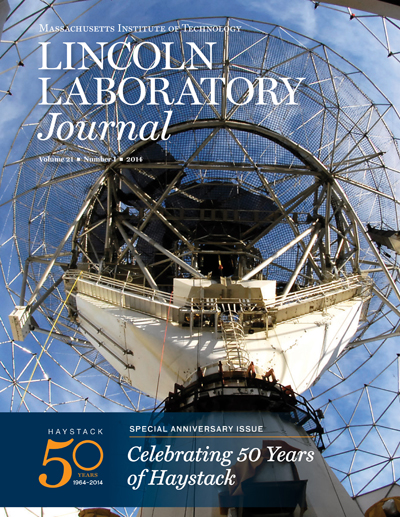Lincoln Laboratory Journal - Volume 21, Number 1
Special Anniversary Issue
Celebrating 50 Years of Haystack

History of Haystack
William M. Brown and Antonio F. Pensa
In the 1950s, Lincoln Laboratory built the Millstone Hill radar in response to the national need for a tracking radar with a specific sensitivity requirement. The Haystack radar, constructed in the following decade, marked the next technological step in the evolution of high-performance microwave systems. Over the years, Haystack has undergone several modifications and upgrades that have enhanced its utility in a variety of applications and developed its reputation as a premier microwave facility.
Insights into the Universe: Astronomy with Haystack's Radio Telescope
Alan R. Whitney, Colin J. Lonsdale, and Vincent L. Fish
MIT Haystack Observatory has been advancing radio astronomy and radio science for 50 years. Experiments and observations made using the radio systems developed and operated by Haystack Observatory have corroborated Einstein's general theory of relativity, pioneered the astronomical and geodetic use of very-long-baseline interferometry, and opened a new window for the study of black holes.
Development of the Haystack Ultrawideband Satellite Imaging Radar
Mark G. Czerwinski and Joseph M. Usoff
In February 2014, the Haystack Ultrawideband Satellite Imaging Radar joined the U.S. Space Surveillance Network as the highest-resolution space-object-imaging radar in the world. Its principal mission is to collect space-object identification and characterization data in support of space situational awareness.
Construction of the HUSIR Antenna
Nikolas T. Waggener
To add W-band capability to the Haystack X-band radar system, its 120-foot-diameter antenna was replaced with a new Cassegrain antenna with a surface tolerance of less than 100 μm. The installation of this antenna and its support systems was an incredibly challenging engineering construction project.
Optimizing the HUSIR Antenna Surface
Joseph M. Usoff, Michael T. Clarke, Chao Liu, and Mark J. Silver
The primary objective of the HUSIR upgrade was to significantly improve the imaging resolution achievable by the Haystack radar. To meet this image resolution objective, a W-band (96 GHz center frequency, 3 mm wavelength) capability was added to the radar. W band provides the necessary bandwidth for high-resolution imaging, but its much smaller (than the original X band) operating wavelength makes the requirements on the antenna much more stringent and challenging to achieve.
The HUSIR W-Band Transmitter
Michael E. MacDonald, James P. Anderson, Roy K. Lee, David A. Gordon, and G. Neal McGrew
The HUSIR transmitter leverages technologies developed for diverse applications, such as plasma fusion, space instrumentation, and materials science, and combines them to create what is, to our knowledge, the most advanced millimeter-wave radar transmitter in the world. Overall, the design goals of the HUSIR transmitter were met in terms of power and bandwidth, and the images collected by HUSIR have validated the performance of the transmitter system regarding phase characteristics. At the time of this publication, the transmitter has logged more than 4500 hours of trouble-free operation, demonstrating the robustness of its design.
HUSIR Signal Processing
James V. Eshbaugh, Robert L. Morrison, Jr., E. Weber Hoen, Timothy C. Hiett, and Gerald R. Benitz
Existing imaging radars lack the high-resolution imaging capability needed to adequately characterize the recent spate of small satellites. The size of a typical microsatellite (tens of centimeters) is on the order of a single pixel at X band (10 GHz). Radar image resolution is inversely proportional to the bandwidth of the radar, driving radars to larger bandwidths to achieve the required resolution and, consequently, to higher frequencies to access appropriate spectrum regions. This increase in complexity has cascading effects on the hardware (generating the appropriate frequencies and bandwidths) and software of the radar system. The real-time software must process nearly an order of magnitude more data with every pulse. The image processing algorithms that have performed well for many years fail to generate high-quality images, requiring a ground-up review and rewrite of the code.